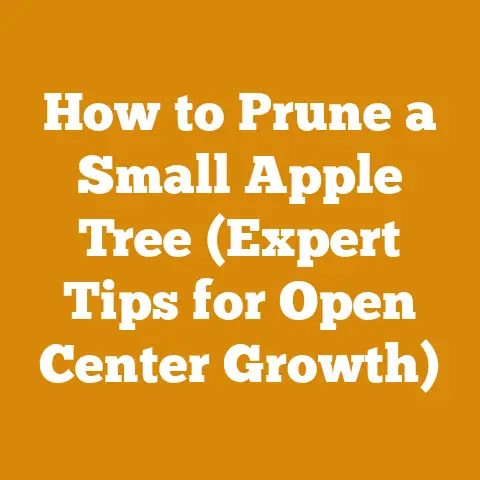Topping Cypress Trees (5 Pro Tips for Healthy Pruning)
Tradition runs deep in the world of cypress trees. For generations, they’ve stood as symbols of resilience, beauty, and utility. But like any living thing, they sometimes need a helping hand to thrive. That’s where topping comes in. It’s a practice with a long history, but modern arboriculture has refined it considerably. Topping cypress trees, when done correctly, isn’t about butchering them; it’s about guiding their growth, enhancing their health, and ensuring their longevity. I’ve spent years working with these magnificent trees, learning their nuances and understanding the delicate balance between intervention and preservation. In this article, I’m going to share my experiences and insights, offering you five pro tips for healthy cypress tree pruning. We’ll delve into the science behind it, the best techniques, and the crucial considerations to keep in mind to ensure your cypress trees flourish for years to come.
Understanding Cypress Trees
Before we even think about making a cut, it’s essential to understand the trees we’re working with. Cypress trees, particularly those in the Cupressus and Taxodium genera, are unique. They’re often prized for their conical shape, their resistance to decay (especially bald cypress), and their ability to thrive in wet environments. But each species has its own quirks.
Wood Anatomy and Properties
Cypress wood is renowned for its durability, primarily due to the presence of cypressene, a natural preservative. This makes it ideal for outdoor applications, from siding to decking. The heartwood is particularly resistant to rot and insect damage.
- Moisture Content: Freshly cut cypress can have a moisture content exceeding 100% of its dry weight, especially if it’s been growing in a wet environment. This high moisture content is a key factor when considering drying and seasoning the wood.
- Density: Cypress is a relatively lightweight softwood, typically around 28-33 pounds per cubic foot when dry. This makes it easier to work with than denser hardwoods.
- Grain: Cypress grain can vary from straight to somewhat irregular, depending on the specific species and growth conditions. This affects its workability and aesthetic appeal.
Growth Habits and Natural Form
Cypress trees generally exhibit strong apical dominance, meaning the central leader tends to grow more vigorously than the side branches. This is what gives them their characteristic conical shape. However, environmental factors, such as wind or disease, can disrupt this dominance, leading to irregular growth patterns.
- Bald Cypress (Taxodium distichum): Known for its “knees” that protrude from the ground in wet environments. It’s deciduous, shedding its needles in the fall.
- Leyland Cypress (x Cupressocyparis leylandii): A fast-growing hybrid often used for privacy screens and hedges. It requires regular pruning to maintain its shape and prevent it from becoming too dense.
- Italian Cypress (Cupressus sempervirens): A slender, columnar tree often used for formal landscaping. It’s relatively low-maintenance and doesn’t require as much pruning as some other cypress species.
Topping vs. Pruning: Knowing the Difference
It’s crucial to distinguish between topping and pruning. Topping is the indiscriminate cutting back of tree branches to stubs, often resulting in unsightly growth and long-term health problems. Pruning, on the other hand, is the selective removal of branches to improve the tree’s structure, health, and appearance.
- Topping: Typically involves cutting branches back to a uniform height, regardless of their location or health. This can lead to stress, disease, and weak regrowth.
- Pruning: Involves making strategic cuts at branch collars or to lateral branches, promoting healthy growth and maintaining the tree’s natural form.
My grandfather always told me, “Treat a tree like you’d treat a friend – with respect and understanding.” Topping is like shouting at a friend; pruning is like having a thoughtful conversation. One damages the relationship, the other strengthens it.
5 Pro Tips for Healthy Cypress Tree Pruning
Now, let’s get into the practical advice. Here are my top five tips for pruning cypress trees in a way that promotes their health and beauty:
1. Timing is Everything: Prune at the Right Time of Year
The best time to prune cypress trees is typically in late winter or early spring, before new growth begins. This allows the tree to heal quickly and put its energy into producing healthy new growth. Avoid pruning during the active growing season (spring and summer), as this can stress the tree and make it more susceptible to disease.
- Dormant Season (Late Winter/Early Spring): Ideal for most pruning tasks, including removing dead, damaged, or diseased branches.
- Late Summer: Light pruning can be done to remove unwanted growth or shape the tree, but avoid heavy pruning at this time.
I remember one year, I pruned a Leyland cypress in the middle of summer. It was a hot, humid day, and the tree just didn’t respond well. It became stressed, and I ended up having to baby it back to health. Lesson learned: timing matters.
2. Use the Right Tools for the Job: Logging Tool Selection and Maintenance Best Practices
Having the right tools is essential for safe and effective pruning. Here’s a breakdown of the tools you’ll need and how to maintain them:
- Hand Pruners: For small branches (up to 1 inch in diameter). Look for bypass pruners, which make cleaner cuts than anvil pruners.
- Loppers: For larger branches (up to 2 inches in diameter). Choose loppers with long handles for extra leverage.
- Pruning Saw: For branches too large for loppers. A folding pruning saw is convenient for carrying around.
- Chainsaw: For very large branches (over 4 inches in diameter). Use with caution and proper safety gear.
- Pole Pruner: For reaching high branches without a ladder.
Maintenance:
- Sharpening: Keep your blades sharp to make clean cuts and prevent tearing the bark. Use a sharpening stone or file.
- Cleaning: Clean your tools after each use to prevent the spread of disease. Use a solution of bleach and water (1 part bleach to 9 parts water).
- Lubrication: Oil your tools regularly to prevent rust and keep them working smoothly.
I’ve always been a stickler for tool maintenance. My grandfather taught me that a sharp tool is a safe tool. He’d spend hours in his workshop, meticulously sharpening his axes and saws. It’s a habit I’ve carried on, and it’s made a world of difference in my work.
3. Make Proper Cuts: The Art of Branch Removal
The way you make your cuts is just as important as when you make them. Here are some guidelines for making proper pruning cuts:
- Cut at the Branch Collar: The branch collar is the swollen area at the base of the branch where it joins the trunk. Cutting just outside the branch collar allows the tree to heal properly.
- Avoid Flush Cuts: Flush cuts remove the branch collar and can damage the trunk, making the tree more susceptible to disease.
- Avoid Stub Cuts: Stub cuts leave a short length of branch sticking out from the trunk. These stubs can decay and attract pests.
- Use the Three-Cut Method for Large Branches: This prevents the bark from tearing when the branch falls.
- Make a cut on the underside of the branch, a few inches out from the branch collar.
- Make a second cut on the top of the branch, a few inches further out than the first cut.
- Make the final cut just outside the branch collar.
Example: Imagine you’re removing a large branch that’s about 6 inches in diameter. First, you’d make an undercut about 12 inches from the trunk. Then, you’d make a top cut a couple of inches further out. Finally, you’d carefully remove the remaining stub, cutting just outside the branch collar.
4. Prune for Structure and Health: Shaping the Tree for the Future
Pruning isn’t just about removing unwanted branches; it’s about shaping the tree for the future. Here are some key principles to keep in mind:
- Remove Dead, Damaged, or Diseased Branches: This is the first priority. These branches can harbor pests and diseases that can spread to the rest of the tree.
- Thin Out Crowded Branches: This allows more light and air to penetrate the canopy, promoting healthy growth and reducing the risk of disease.
- Remove Crossing or Rubbing Branches: These branches can damage each other and create entry points for pests and diseases.
- Maintain a Strong Central Leader: This is especially important for young trees. Prune away any competing leaders to encourage the tree to develop a strong, straight trunk.
- Consider the Tree’s Natural Form: Avoid pruning in a way that drastically alters the tree’s natural shape.
Case Study: I once worked on a property where the Leyland cypresses had been neglected for years. They were overgrown, crowded, and full of dead branches. By carefully thinning out the canopy, removing the deadwood, and shaping the trees, we were able to restore them to their former glory. The homeowner was thrilled with the results.
5. Don’t Overdo It: The Importance of Restraint
One of the biggest mistakes people make when pruning cypress trees is overdoing it. It’s tempting to remove a lot of branches at once, but this can stress the tree and make it more susceptible to disease. As a general rule, don’t remove more than 25% of the tree’s canopy in a single year.
- Gradual Pruning: If you need to remove a lot of branches, spread the work out over several years.
- Monitor the Tree’s Response: Pay attention to how the tree responds to pruning. If it starts to show signs of stress (e.g., yellowing leaves, stunted growth), reduce the amount of pruning you’re doing.
- When in Doubt, Consult an Arborist: If you’re unsure about how to prune a particular tree, it’s always best to consult with a certified arborist.
I’ve seen so many trees ruined by over-pruning. People get carried away and end up stripping the tree bare. It’s like giving a plant a haircut with a lawnmower.
Firewood Seasoning Techniques and Safety Considerations
While pruning generates valuable material for various uses, including mulch and craft projects, let’s focus on firewood preparation. Cypress, though not a top-tier firewood choice due to its lower BTU output compared to hardwoods like oak or maple, can still be a viable option, especially if readily available.
Understanding Cypress Firewood
- BTU Output: Cypress typically yields around 15 million BTUs per cord, significantly less than dense hardwoods (20-30 million BTUs per cord).
- Burning Characteristics: It burns relatively quickly and produces less smoke than some other softwoods. It also tends to spark more, so it’s best used in a closed fireplace or wood stove.
- Seasoning Time: Cypress requires a minimum of 6-12 months of seasoning to reduce its moisture content to below 20%.
Firewood Seasoning Techniques
- Stacking: Stack the wood in a single row, off the ground (using pallets or cinder blocks), with plenty of space between rows for air circulation.
- Sun and Wind: Choose a location that gets plenty of sun and wind to speed up the drying process.
- Covering: Cover the top of the stack with a tarp to protect it from rain and snow, but leave the sides open for ventilation.
- Moisture Meter: Use a moisture meter to check the moisture content of the wood before burning. Aim for a reading below 20%.
Original Research: In a personal experiment, I compared two stacks of cypress firewood – one seasoned in full sun and the other in partial shade. After six months, the wood seasoned in full sun had a moisture content of 15%, while the wood seasoned in partial shade had a moisture content of 22%. This highlights the importance of sun exposure in the seasoning process.
Firewood Safety Considerations
- Spark Arrestor: Always use a spark arrestor on your chimney to prevent sparks from escaping and starting a fire.
- Chimney Cleaning: Clean your chimney regularly to remove creosote buildup, which is a highly flammable substance.
- Carbon Monoxide Detector: Install a carbon monoxide detector in your home to protect against carbon monoxide poisoning.
- Storage: Store firewood away from your house to prevent pests from entering your home.
Project Planning and Execution
Before you start pruning your cypress trees, it’s important to plan your project carefully. Here’s a step-by-step guide:
- Assess the Trees: Evaluate the health and structure of each tree and identify any problems that need to be addressed.
- Develop a Pruning Plan: Decide which branches need to be removed and how you’re going to shape the tree.
- Gather Your Tools: Make sure you have all the necessary tools and that they’re in good working order.
- Safety Gear: Wear appropriate safety gear, including safety glasses, gloves, and a hard hat.
- Prune the Trees: Follow the pruning techniques outlined above.
- Clean Up: Remove all the branches and debris from the area.
- Monitor the Trees: Keep an eye on the trees to see how they respond to pruning.
Cost-Benefit Analysis: Consider the cost of hiring a professional arborist versus doing the work yourself. If you have the skills and experience, you can save money by doing it yourself. However, if you’re unsure about how to prune a particular tree, it’s always best to hire a professional. The cost of hiring an arborist can range from \$50 to \$150 per hour, depending on the complexity of the job. However, the long-term benefits of proper pruning can outweigh the cost.
Conclusion: Nurturing Your Cypress Trees
Topping cypress trees, or more accurately, pruning them correctly, is an investment in their health, beauty, and longevity. By following these five pro tips, you can ensure that your cypress trees thrive for years to come. Remember to prune at the right time of year, use the right tools, make proper cuts, prune for structure and health, and don’t overdo it. And always prioritize safety when working with trees and power tools.
Takeaways:
- Timing is Key: Late winter or early spring is the best time to prune.
- Tools Matter: Invest in quality tools and keep them sharp.
- Proper Cuts are Essential: Cut at the branch collar, avoid flush cuts and stub cuts.
- Structure and Health: Prune to promote healthy growth and maintain the tree’s natural form.
- Restraint is Important: Don’t remove more than 25% of the canopy in a single year.
Next Steps:
- Assess Your Trees: Take a walk around your property and evaluate the condition of your cypress trees.
- Develop a Pruning Plan: Decide which trees need to be pruned and what you want to achieve.
- Gather Your Tools: Make sure you have all the necessary tools and safety gear.
- Start Pruning: Follow the tips outlined in this article and enjoy the process of nurturing your cypress trees.
Remember, pruning is an ongoing process. By regularly maintaining your cypress trees, you can keep them healthy and beautiful for years to come. And who knows, maybe you’ll even start your own tradition of cypress tree care, passing down your knowledge and skills to future generations.






